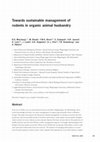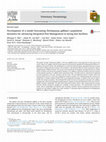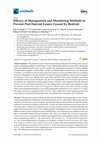Papers by Bastiaan Meerburg

Wereldwijd wordt steeds sterker gepleit voor een verschuiving naar duurzame ontwikkeling. De bewu... more Wereldwijd wordt steeds sterker gepleit voor een verschuiving naar duurzame ontwikkeling. De bewustwording hiertoe werd al lang geleden ingezet door onder andere Rachel Carson in het boek Silent Spring (1962) en de Club van Rome in haar rapport Limits to Growth (1972). In het streven naar verduurzaming van onze activiteiten is recentelijk een nieuw concept naar voren gebracht: Cradle to Cradle (C2C). Vooral in Nederland heeft dit concept veel politici, wetenschappers, ondernemers en het publiek ertoe gebracht na te denken over de praktijk van C2C. Het gaat om vragen als: hoe we producten ontwerpen, produceren, gebruiken en vervolgens opnieuw gebruiken in plaats van ze te dumpen of te vernietigen. Met onder meer projecten rondom de stad Almere, de ontwikkeling van een Happy Shrimp Farm en de opzet van de Floriade door de gemeente Venlo heeft het concept snel ingang gevonden. Het blijkt echter niet gemakkelijk te zijn om in de praktijk de toepassing van C2C op industriele productiepro...
Outlook on Agriculture, 2003

Wetlands Ecology and Management, 2010
In Western-Europe, agricultural practices have contributed to environmental problems such as eutr... more In Western-Europe, agricultural practices have contributed to environmental problems such as eutrophication of surface and ground water, flooding, drought and desiccation of surrounding natural habitats. Solutions that reduce the impact of these problems are urgently needed. Common reed (Phragmites australis) is capable of sanitizing surface water and may function as green energy source because of its high productivity. Here, the results of an experiment in a constructed wetland in the Netherlands are presented where two different sanitation treatments were compared. Depending on the residence time and volume per unit area, reed is capable to reduce the total amount of nitrogen in the water with average efficiencies from 32 to 47% and the total amount of phosphorous with 27-45%. Although biomass production still varies largely between different parts of the constructed wetland, a rapid increase in biomass was observed since planting. Constructed wetlands with reed provide opportunities to improve water quality and reed produces enough biomass to serve as green energy source. Moreover, these wetlands also function as a flood water reservoir and are possibly advantageous for biodiversity. The optimal moment of reed harvesting depends on the goal of the owner. This moment should be chosen wisely, as it may have consequences for reed filter regeneration, biomass production, biodiversity, methane emission and water sanitation efficiency.

Regional Environmental Change, 2011
Agriculture is vulnerable to climate change in multiple ways. Here, we use the northern region of... more Agriculture is vulnerable to climate change in multiple ways. Here, we use the northern region of the Netherlands as a case study to explore how risk assessments for climate change impacts on crop production can address multiple vulnerabilities. We present a methodology, which we call agro climate calendar (ACC) that (i) includes potential yield losses, as well as loss of product quality, and (ii) assesses the risks of a variety of climate factors including weather extremes and the emergence and abundance of pests and diseases. Climate factors are defined for two time slices: 1990 (1976-2005) and 2040 (2026-2055); the frequency of occurrence of the factors is compared for the two periods, and the resulting frequency shifts are presented in a crop calendar on a monthly basis. This yields an indication of the magnitude and direction of changes in climatic conditions that can lead to damage by extreme events and pests and diseases. We present results for the two most important crops in the region, seed potato, and winter wheat. The results provide a good overview of risks from climate factors, and the most important threats and opportunities are identified. This semi-quantitative approach is firmly rooted in farm management, which is the level where operational and strategic decisions are made. Thus, the approach is well suited to assist local stakeholders such as farmers and policy makers to explore farm-level adaptation. This work is complementary to previous modeling work that focused mainly on the relation between mean climate change factors (i.e., temperature) and crop yield. Keywords Climate change Á Extreme events Á Agriculture Á Adaptation Á Arable Á Risk assessment Á Vulnerability Á The Netherlands
Environmental Science & Policy, 2010

Wereldwijd wordt steeds sterker gepleit voor een verschuiving naar duurzame ontwikkeling. De bewu... more Wereldwijd wordt steeds sterker gepleit voor een verschuiving naar duurzame ontwikkeling. De bewustwording hiertoe werd al lang geleden ingezet door onder andere Rachel Carson in het boek Silent Spring (1962) en de Club van Rome in haar rapport Limits to Growth (1972). In het streven naar verduurzaming van onze activiteiten is recentelijk een nieuw concept naar voren gebracht: Cradle to Cradle (C2C). Vooral in Nederland heeft dit concept veel politici, wetenschappers, ondernemers en het publiek ertoe gebracht na te denken over de praktijk van C2C. Het gaat om vragen als: hoe we producten ontwerpen, produceren, gebruiken en vervolgens opnieuw gebruiken in plaats van ze te dumpen of te vernietigen. Met onder meer projecten rondom de stad Almere, de ontwikkeling van een Happy Shrimp Farm en de opzet van de Floriade door de gemeente Venlo heeft het concept snel ingang gevonden. Het blijkt echter niet gemakkelijk te zijn om in de praktijk de toepassing van C2C op industriele productieprocessen te realiseren.

Bba Bioenergetics, 2006
Borrelia burgdorferi Unknown Unknown (~6,000?) Rickettsia typhi Unknown <5* Ehrlichia spp. 0 <5 L... more Borrelia burgdorferi Unknown Unknown (~6,000?) Rickettsia typhi Unknown <5* Ehrlichia spp. 0 <5 Lassa virus 0 <5* Junin virus / Machupo virus 0 0* Hepatitis E virus Unknown Unknown* Cowpox virus Unknown <5 Avian Influenza virus 89 89* Hanta viruses 0 Unknown* Tick-borne encephalitis virus 0 0* Leishmania spp. Unknown 100-150* Babesia spp. 0 0* Entamoeba spp. 16 <25 Toxoplasma gondii Unknown 12,000 Trichinella spiralis 0 <10 Fasciola hepatica Unknown Unknown * imported diseases from other countries, e.g. by travelling (source: RIVM Infectieziekten Bulletin, other sources mentioned in the text) serious and sometimes even fatal consequences. This occurs when a woman is infected for the first time during pregnancy and the parasite crosses the placenta and invades the tissues of the foetus (Gilbert, 2000). The severity of infection depends on the time of infection during the pregnancy: severity is the greatest during the early stage of pregnancy and infection may then CHAPTER 2
Veterinary Microbiology, 2010
In a recent paper Messens et al. (2009) investigate the genetic diversity of thermotolerant Campy... more In a recent paper Messens et al. (2009) investigate the genetic diversity of thermotolerant Campylobacter in commercial broiler flocks and in the environment of broiler farms in Belgium. One of their conclusions is that although rodents can serve as vectors and reservoirs of Campylobacter (Meerburg et al., 2006) these animals only impose a limited risk for introducing Campylobacter in broiler
Onze maatschappij is de afgelopen eeuw sterk veranderd. Waren vroeger boeren meer regel dan uitzo... more Onze maatschappij is de afgelopen eeuw sterk veranderd. Waren vroeger boeren meer regel dan uitzondering, tegenwoordig is dat anders. Daardoor komen burgers steeds minder in contact met boeren en hebben zij niet of nauwelijks meer weet van wat op het boerenbedrijf precies speelt. Deze kloof van onwetendheid leidt tot een discrepantie tussen wat burgers denken dat zich afspeelt op het boerenbedrijf en wat daadwerkelijk daar gebeurt. Het debat over de veehouderij wordt nu dan ook grotendeels op basis van emotie gevoerd, en niet op basis van onderliggende feiten of waarden. In dit essay pleiten wij ervoor om deze kloof te dichten, zodat de kwaliteit van de discussie over de toekomst van de veehouderij kan verbeteren.

Organic and free range pigs are potentially exposed to a wider range of parasites and zoonotic ch... more Organic and free range pigs are potentially exposed to a wider range of parasites and zoonotic challenges. The livestock Subproject QLIF addresses 4 strategies to combat these challenges, and the present paper describes the initial results. Rodent control is the first strategy, and a survey concludes that Salmonella and Campylobacter infections were encountered in house mice and Norway rats, but not in other species. T. gondii antibodies could be detected in 6.4% of the blood samples taken from 235 wild small mammals. To reduce the presence of rodents around farms, the use of live-traps may be a good alternative for the use of rodenticides on organic farms. A second strategy is aimed at directing pig dunging behaviour in such a way that contact with (infected) faeces is minimised. The study showed that a rooting area resulted in a cleaner outdoor are and an extra outdoor drinker led to a cleaner area around the drinker, but to a dirtier indoor area. However, no difference in Ascaris...

From 26 to 28 May 2004 an international seminar was held in Wageningen, the Netherlands, about cu... more From 26 to 28 May 2004 an international seminar was held in Wageningen, the Netherlands, about current knowledge and advice on rodent management on organic pig and poultry farms in Western Europe. This paper summarizes the discussions. Rodent management is necessary to protect the food production chain from health hazards to livestock and humans. Some organic farmers prefer biological rodent control, but since rodents can also transmit diseases this bears certain risks for the production of healthy livestock and safe food. Effective rodent management requires a thorough understanding of the biology of the pest species concerned. These can be divided into two groups: field rodents, such as voles, and commensal rodents like house mice and rats. The objective of managing field rodents is to minimize livestock exposure to these vectors, and to regulate their populations in case their density is expect-195 NJAS 52-2, 2004 ed to grow dramatically. Infestation of livestock facilities with commensal rodents can be prevented, but once they are present, their eradication must be aimed for. General elements of rodent management are (1) the prevention of rodent infestations through strategic actions such as modifying the habitat or rodent proofing of the buildings, (2) monitoring their appearance and population density, and (3) rodent control measures. A number of possible management actions is described to provide a basis for examining the measures' social acceptability, their economic and environmental impacts, and their efficacy.

Veterinary Parasitology
The poultry red mite, Dermanyssus gallinae, is the most significant pest of egg laying hens in ma... more The poultry red mite, Dermanyssus gallinae, is the most significant pest of egg laying hens in many parts of the world. Control of D. gallinae could be greatly improved with advanced Integrated Pest Management (IPM) for D. gallinae in laying hen facilities. The development of a model forecasting the pests' population dynamics in laying hen facilities without and post-treatment will contribute to this advanced IPM and could consequently improve implementation of IPM by farmers. The current work describes the development and demonstration of a model which can follow and forecast the population dynamics of D. gallinae in laying hen facilities given the variation of the population growth of D. gallinae within and between flocks. This high variation could partly be explained by house temperature, flock age, treatment, and hen house. The total population growth variation within and between flocks, however, was in part explained by temporal variation. For a substantial part this variation was unexplained. A dynamic adaptive model (DAP) was consequently developed, as models of this type are able to handle such temporal variations. The developed DAP model can forecast the population dynamics of D. gallinae, requiring only current flock population monitoring data, temperature data and information of the dates of any D. gallinae treatment. Importantly, the DAP model forecasted treatment effects, while compensating for location and time specific interactions, handling the variability of these parameters. The characteristics of this DAP model, and its compatibility with different mite monitoring methods, represent progression from existing approaches for forecasting D. gallinae that could contribute to advancing improved Integrated Pest Management (IPM) for D. gallinae in laying hen facilities.

Animals
The presence of pest rodents around food production and storage sites is one of many underlying p... more The presence of pest rodents around food production and storage sites is one of many underlying problems contributing to food contamination and loss, particularly influencing food and nutrition security in low-income countries. By reducing both pre- and post-harvest losses by rodents, millions of food-insecure people would benefit. As there are limited quantitative data on post-harvest rice losses due to rodents, our objectives were to assess stored rice losses in local households from eight rural communities and two rice milling factories in Bangladesh and to monitor the effect of different rodent control strategies to limit potential losses. Four treatments were applied in 2016 and 2017, (i) untreated control, (ii) use of domestic cats, (iii) use of rodenticides, (iv) use of snap-traps. In total, over a two-year period, 210 rodents were captured from inside people’s homes, with Rattus rattus trapped most often (n = 91), followed by Mus musculus (n = 75) and Bandicota bengalensis (...

Pest management science, Jan 29, 2017
Current reactive pest management methods have serious drawbacks such as the heavy reliance on che... more Current reactive pest management methods have serious drawbacks such as the heavy reliance on chemicals, emerging genetic rodenticide resistance, and high secondary exposure risks. Rodent control needs to be based on pest-species ecology and ethology to facilitate development of ecologically-based rodent management (EBRM). An important aspect of EBRM is a strong understanding of rodent pest species ecology, behaviour, and spatiotemporal factors. Gaining insight in the behaviour of pest-species is a key aspect of EBRM. The landscape of fear is a mapping of the spatial variation in the foraging cost arising from the risk of predation and reflects levels of fear a prey species perceives at different locations within its home range. In practice, the landscape of fear (LOF) is a mapping of habitat use as a result of perceived fear, which shows where bait or traps are most likely to be encountered and used by rodents. Several studies link perceived predation risk of foraging animals with ...








Uploads
Papers by Bastiaan Meerburg